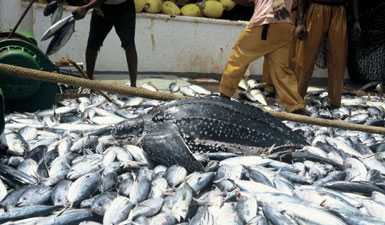 …at least that’s how the song is going to go about 50 years from now if nothing changes. The oceans are going to turn into liquid deserts. Goodbye sushi for the up market and fish and chips for the down. If you follow eco-topics at all, and you read the New York Times or The Independent or the BBC’s website, you probably already know all about this. But what no one offered was what we individual fish-stick eaters can do to help. That’s going to be the main point of this post. But first a little background for those who missed the November stories.
…at least that’s how the song is going to go about 50 years from now if nothing changes. The oceans are going to turn into liquid deserts. Goodbye sushi for the up market and fish and chips for the down. If you follow eco-topics at all, and you read the New York Times or The Independent or the BBC’s website, you probably already know all about this. But what no one offered was what we individual fish-stick eaters can do to help. That’s going to be the main point of this post. But first a little background for those who missed the November stories.
That we have only five decades left before our fish menu shrinks to zero is the scientific conclusion of a team of ecologists and economists from a dozen research centers who have studied detailed records on fish catches going back to 1950. Their study, published in the November issue of the journal Science, found that the number of commercial fisheries that have collapsed is accelerating and that the total eradication of all fish stocks in the world is due to be completed by 2048. This comes when just about everybody nutritionally inclined is saying that fish is the best food going.
Already, 29 per cent of the world’s fisheries have collapsed. In some habitats, over fishing has led to the extinction of a number of species. “This isn’t predicted to happen, this is happening now. If biodiversity continues to decline, the marine environment will not be able to sustain our way of life, indeed it may not be able to sustain our lives at all,” said Nicola Beaumont, an ecological economist who took part in the study from Plymouth Marine Laboratory, according to The Independent.
The good news is that the trend is reversible if the fisheries are managed responsibly, which means, largely, taking fewer fish out of those parts of the ocean where stocks are depleted. The study participants called for the establishment of an international approach to protecting the oceans along the lines of the coastal waters of north-west America and Canada which are one of the best-preserved fisheries in the world. But until that happens, individual action—you know, by us—is particularly important. As for my little family, for the purposes of the No Impact experiment, we have given up eating anything that, in my wife Michelle’s words, “wiggles or has a face.” That’s one way to ensure the oceans aren’t over fished. But if you are worried about your Omega-3s, it is also possible to obtain seafood sustainably.
The Worldwatch Institute advocates:
- Eating less of the big fish such as salmon, tuna, swordfish and sharks, which are the most vulnerable populations.
- Eating lower on the marine food chain, including smaller species that are less endangered such as clams, oysters, mollusks, anchovies, and sardines.
- Choosing fish caught by line, pot, or net (or other artisanal methods) and avoiding fish caught in massive trawl nets which pull everything out of the ocean whether it is the intended catch or not .
On top of those tips, the World Wildlife Fund recommends that you only buy sustainably-harvested fish that has been certified by the Marine Stewardship Council and bears its logo (shown here) on the packaging. You can find MSC certified fish suppliers here. If the restaurant or grocery store you frequent doesn’t carry MSC certified fish, you can download a letter to send to the manager here.
[Since I posted, early commenters have added some excellent further resources which I thought I should move into the main post:
- Monterey Bay Aquarium’s guide to sustainable seafood choices (Thanks Jason)
- Ocean Alive’s best and worst seafood choices (Thanks Susan)
- An issue of Mother Jones devoted entirely to over fishing (Thanks Sara)
- Dr David Suzuki’s page on ocean ecology (Thanks Tony)]
Finally, let me leave you with a Worldwatch Institute video on the subject.
This post also appears in my Green Parenting column for Time Out New York Kids, appearing every Wednesday. For resources on eco-friendly stores and restaurants, or simply to plan a weekend outing, visit them at tonykids.com.